The Advanced Workshop on New Advances in Diagnosis and Treatment of Neurodegenerative Diseases and Design of Clinical Research was held online from July 2nd to 3rd by the Innovation Center of Neurological Diseases, Xuanwu Hospital of Capital Medical University.
The conference invited more than 20 domestic top experts to give wonderful lectures on the new progress in the diagnosis and treatment of neurodegenerative diseases such as Alzheimer’s disease, frontotemporal dementia, Parkinson’s disease, motor neuron disease and other diseases and new information on clinical research.
Early diagnosis of Alzheimer’s disease is the first major scientific problem- Lectured by Jianping Jia
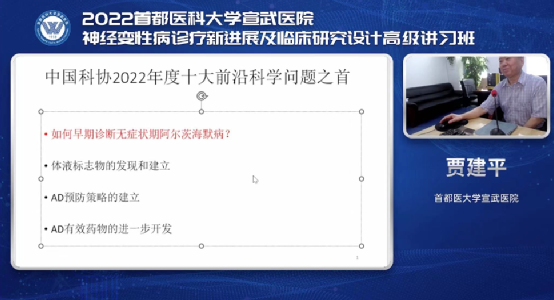
The meeting was opened by Professor Jianping Jia, a veteran expert in neurology. Professor Jia talked about the early diagnosis of Alzheimer’s disease (AD) at the meeting of the Association for Science and Technology, and was selected as the top issue of this major scientific issue. He mentioned that AD seriously affects the health of the elderly in our country. The first 15 to 20 years of AD symptoms are the best time to treat the disease. At this time, the pathological changes of amyloid plaques and neurofibrillary tangles in the patient’s brain begin to appear, accompanied by neuroinflammatory response and oxidative stress. and neurological impairment.
A Preliminary Study on Early Intervention of AD Based on Mind-China Cohort – Lectured by Yifeng Du
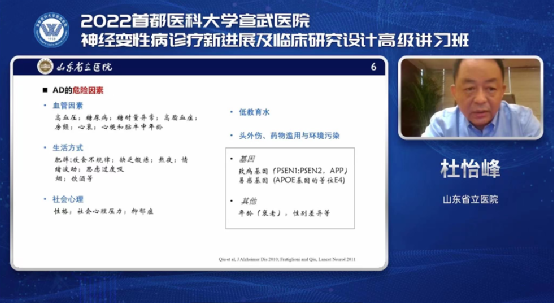
Professor Du from Shandong Provincial Hospital gave a presentation on a preliminary study of AD early intervention based on the Mind-China cohort. The prevention and treatment of Alzheimer’s disease is a challenge to the world. As early as 2012, WHO proposed that early diagnosis and intervention for AD should be strengthened. AD is a preventable disease and requires cooperation from multiple parties, especially the promotion of AD in the whole society. The establishment of a national AD screening network can enable the majority of AD patients to be detected at an early stage, thereby enabling early prevention.
Amyotrophic Lateral Sclerosis-Frontotemporal Spectrum Disease -Lectured by Dongsheng Fan
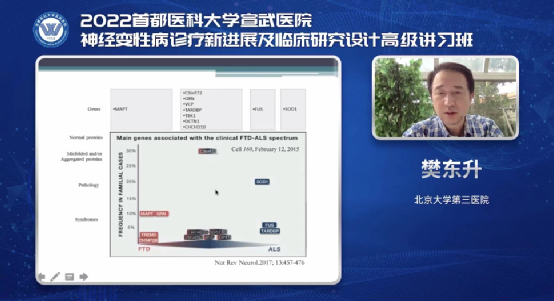
Professor Fan from Peking University Third Hospital gave a detailed report on ALS-frontotemporal lobe spectrum disease. Professor Fan introduced the specific diagnosis process of ALS patients: patients suspected of ALS should first benchmark against the revised ELEscorial or Awaji diagnostic criteria to clarify the diagnosis of ALS; For patients with abnormal ECAS screening scale, detailed and comprehensive neuropsychological, imaging, and genetic examinations are also required. Finally, the Strong2017 revised diagnostic criteria were compared to see if they were in line with ALS-FTSD.
Research on Diagnosis and Treatment of Cerebral Small Vessel Disease -Lectured by Yun Xu
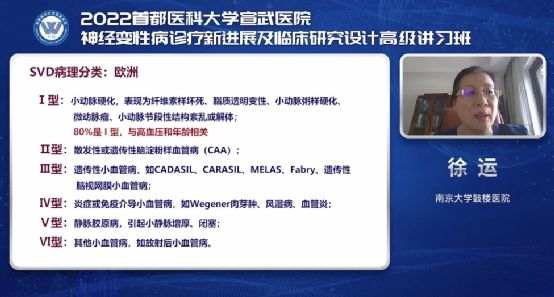
Professor Xu from Drum Tower Hospital Affiliated to Nanjing University School of Medicine introduced the diagnosis and treatment of cerebral small vessel disease. There are six types of cerebral small vessel disease (SVD), usually involving cerebral arterioles, branch arterioles, capillaries, and venules. Its clinical manifestations include a series of clinical syndromes such as abnormal mood, abnormal gait, abnormal urination, stroke, and dementia. Professor Xu introduced the main clinical features of type I SVD, including that the incidence of SVD is 5 to 6 times that of clinical stroke; 60% have insidious onset, and 80% have a progressive course; age-dependent type, which increases with age; subcortical vascular cognitive impairment caused by VD is the most common VCI; SVD is an important cause of vascular depression; 90% of the VCI population has SVD; 30% of AD patients have SVD.
Cerebral hypoperfusion and cognitive impairment—an early biomarker of vascular cognitive impairment -Lectured by Junjian Zhang
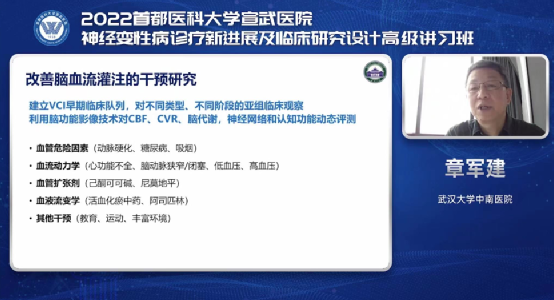
Professor Zhang from Zhongnan Hospital of Wuhan University explained cerebral hypoperfusion and cognitive impairment, mainly focusing on the early biomarkers of vascular cognitive impairment. He introduced that a variety of risk factors including vascular factors lead to impaired BBB and CVR, and reduced cerebral blood flow (CBF) reserve, and CVR damage often occurs before the reduction of resting CBF, brain reserve may reach a plateau in the early stages of AD. Longitudinal studies on the effects of genetic susceptibility and vascular risk factors on neuro-vascular coupling and changes in CBF, and their relationship with cognitive impairment can help to clarify the mechanism of occurrence and development of vascular cognitive impairment. Comprehensive and dynamic assessment of genetic susceptibility and vascular risk factors, monitoring of cognitive function and CBF helps to clarify the pathological mechanism of cognitive impairment, predict the development and prognosis of cognitive impairment diseases, and explore effective intervention methods for changes in CBF at different stages .
Right temporal lobe variant semantic dementia -Lectured by Jiewen Zhang

Professor Zhang from the People’s Hospital of Zhengzhou University gave a detailed introduction on right temporal lobe variant semantic dementia. Professor Zhang mentioned that the anatomical imaging concept of atrophy dominated by the right temporal lobe corresponds to a unique clinical syndrome, including loss of social-emotional semantics (including prosopagnosia), abnormal behavior (lack of empathy, impulsivity, apathy, etc.), memory impairment and so on. These symptom combinations vary from person to person. Combined with imaging, this clinical-imaging syndrome basically belongs to the category of FTLD, which is pathologically uniform and similar to SD. The best diagnostic criteria are still to be verified. In clinical practice, such patients should pay attention to non-verbal semantic barriers and improve the detection of social emotion scales.
Chinese expert consensus on frontotemporal dementia -Lectured by Dantao Peng
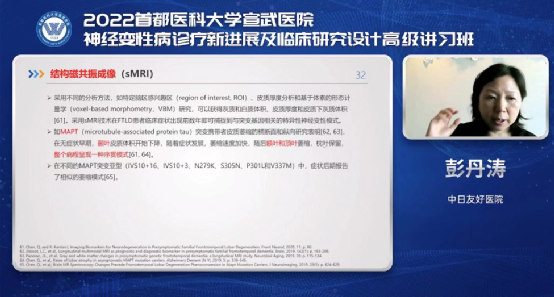
Professor Peng from the China-Japan Friendship Hospital gave a detailed interpretation of the Chinese expert consensus on frontotemporal dementia. FTLD is the second most common cause of early-onset memory impairment, accounting for approximately 10% of all neurodegenerative memory disorders. Determining the total number of people with FTLD pathology is difficult due to diagnostic difficulties, combined with clinical, neuropathological, and genetic heterogeneity, and the incidence and prevalence of FTLD are underestimated worldwide. Therefore, the diagnosis and expert consensus of the frontotemporal lobe are particularly important.
Disease-modifying therapy for Alzheimer’s disease -Lectured by Jianjun Jia
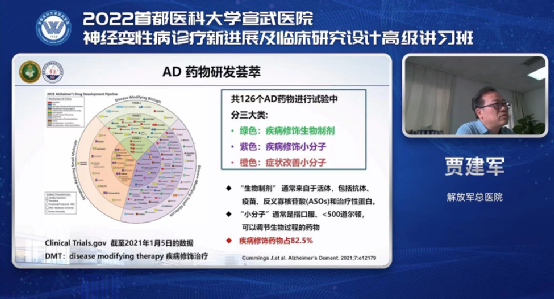
Professor Jia from the Institute of Geriatrics of the PLA General Hospital explained the modification treatment of Alzheimer’s disease. Autophagy is a natural cellular mechanism for the degradation and recycling of toxic waste and organelles, but dysregulation of autophagy damages neurons and causes AD. The main research and development of disease-modifying therapy (DMT) drugs are aimed at the above pathological mechanisms. He mentioned that with the approval of the new AD drug Aducanumab, it has opened up a new starting point for AD drug development. At the same time, biological agents targeting Aβ and tau are still the main research and development hotspots. Lecanemab and donanemab received FDA Breakthrough Therapy Designation. Novel biologics and small molecules such as TrkA allosteric agents, TREM2 agonistic antibodies and other unique mechanisms hold promise for the treatment of AD lesions.
Research progress of Alzheimer’s disease and auditory system -Lectured by Wei Zhang
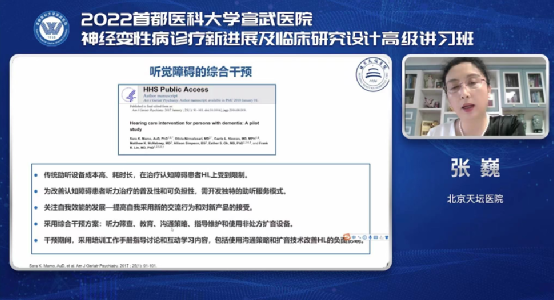
Professor Zhang Wei from the Neurology Center of Beijing Tiantan Hospital gave a detailed explanation on the research progress of Alzheimer’s disease and auditory system. She mainly introduced that AD patients can be accompanied by a variety of visual disorders, and the visual disorders of AD patients are related to the damage of the visual system. AD and visual impairment involve a variety of pathological and biochemical mechanisms, and in-depth research can provide targets for early intervention. Treating ocular diseases associated with AD patients can improve cognitive function. Current research results on related treatments need to be confirmed by large-sample RCT studies. The research on the relationship between AD and visual impairment and the mechanism needs to move forward to the preclinical and early stages to screen high-risk groups and intervene early.
Application of MIBG in the diagnosis and differential diagnosis of PD- Lectured by Houzhen Tuo
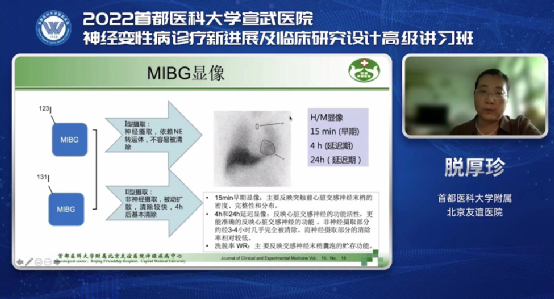
Professor Tuo from Beijing Friendship Hospital Affiliated to Capital Medical University explained the application of MIBG in the diagnosis and differential diagnosis of PD. MIBG has high sensitivity and specificity for PD diagnosis and differential diagnosis. The I-MIBG uptake rate of PD patients was significantly lower than that of RBD-patients. I-MIBG in MSA patients was slightly lower than that in normal controls, and the uptake rate of I-MIBG in ET patients was normal.
Advances in nutritional management of dementia patients- Lectured by Jihui Lv
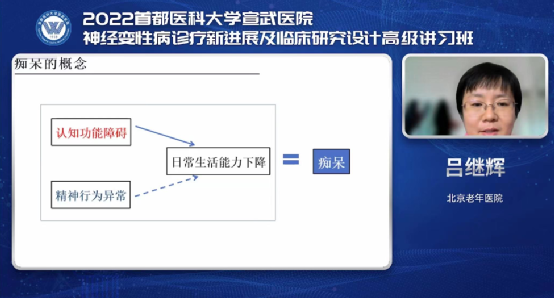
Professor Lv from Beijing Geriatrics Hospital introduced the nutritional management of dementia patients. She explained the European Society of Clinical Nutrition and Metabolism nutrition guidelines for dementia patients, and also explained the influencing factors of AD. She mentioned that malnutrition in a broad sense includes both undernutrition, overweight and obesity, and is synonymous with “undernutrition” in a narrow sense. Malnutrition is caused by unintentional weight loss, low BMI or loss of muscle mass, reduced food intake or absorption, or underlying inflammation caused by acute illness/injury or chronic disease. Dementia creates a vicious cycle of malnutrition.
Chinese expert consensus on AD drug clinical trials- Lectured by Cuibai Wei
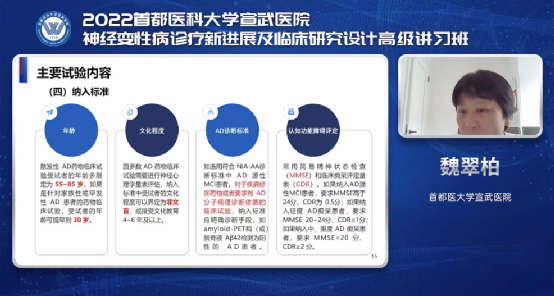
Professor Wei from Xuanwu Hospital of Capital Medical University explained the consensus of Chinese experts on Alzheimer’s disease drug clinical trials. AD is the most common type of dementia, which seriously endangers the health of the elderly and seriously affects social and economic development. It is one of the major public health events facing the world. Clinical trials are a key link in the development of new methods for AD intervention, including parallel design, crossover design, factorial design, group sequential design, and loading design. At present, many AD drug trials adopt a parallel design, AD symptomatic treatment drugs: 6-12 months; AD disease-modifying drugs: 12-24 months; Blank control, placebo control, positive drug control, dose control. Controlled trials can be divided into single-arm clinical trials, two-arm clinical trials, and three-arm clinical trials. It can be divided into single-blind, double-blind and triple-blind. Clinical trials that are not blinded are called open-label trials. Randomization can be divided into fixed randomization and dynamic randomization methods. Fixed randomization methods can be further divided into simple randomization, stratified randomization, block randomization and stratified block randomization. Block randomization is the most commonly used randomization method in AD multicenter clinical trials.
Update and interpretation of clinical diagnostic criteria for familial fatal insomnia- Lectured by Liyong Wu
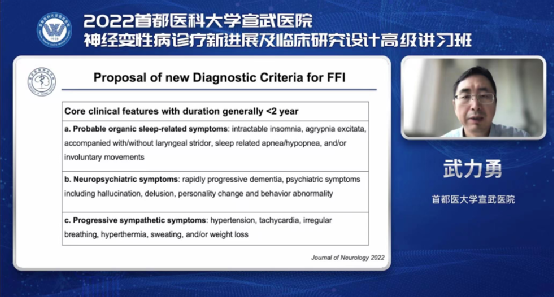
Professor Wu from Xuanwu Hospital of Capital Medical University explained the latest interpretation of the clinical diagnostic criteria for familial fatal insomnia. Arbitrary definitions and ambiguity are reduced with a robust diagnostic item selection procedure based on data analysis and an improved Delphi method. Inclusion of EEG and/or MRI findings as exclusions was defined as family history, limited to possible organic insomnia-related symptoms.
New MDS diagnostic criteria for MSA- Lectured by Wei Mao
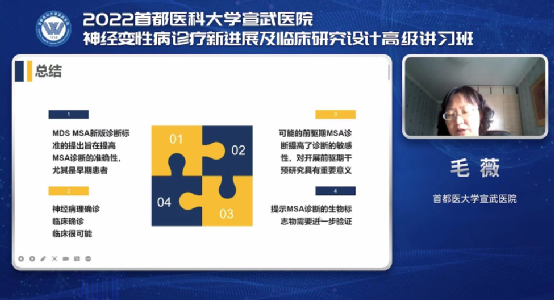
Professor Mao from Xuanwu Hospital of Capital Medical University gave a detailed interpretation of the new MDS standard for multiple system atrophy. Multiple system atrophy (MSA) is an adult-onset, sporadic, progressive neurodegenerative disease. Its clinical features are various combinations of Parkinson’s syndrome, cerebellar syndrome, autonomic failure, and corticospinal tract damage of varying severity. Its pathological features are the accumulation of α-synuclein in aggregated oligodendrocytes to form glial inclusion bodies (GCls) and neuronal loss (mainly in the striatum and olivocerebellar systems).
Linguistic dysfunction in Alzheimer’s disease -Lectured by Aihong Zhou

Professor Zhou from Xuanwu Hospital shared the case of methylmalonic acidemia with everyone, and the case carried out an in-depth explanation of methylmalonic acidemia. A group of diseases commonly found in inborn errors of organic acid metabolism are mainly due to methylmalonyl-CoA mutase deficiency or its coenzyme cobalamin (VitB12) metabolism deficiency. It leads to the accumulation of a large amount of methylmalonic acid in body fluids and tissues, resulting in multi-system damage mainly in the nervous system. MMA is an autosomal recessive disorder that usually presents in infants and young children, and presents with feeding difficulties, developmental delay, epilepsy, retinitis pigmentosa, and damage to the blood system and kidneys. Late-onset cases may have a relatively benign course, possibly due to the loss of partial enzymatic activity, and respond significantly better to treatment than early-onset cases.
Diagnosis and treatment of dementia-Lectured by Wei Wang
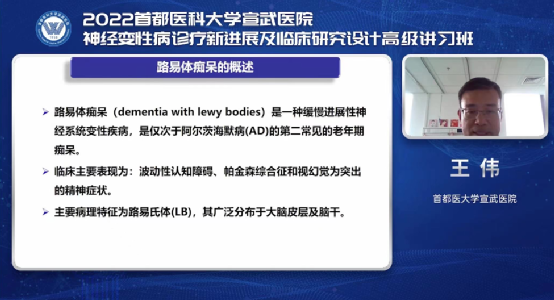
Professor Wang from Xuanwu Hospital of Capital Medical University gave a brilliant explanation on the diagnosis and treatment of dementia-related diseases. Dementia is a syndrome characterized by acquired cognitive impairment as the core, which leads to a significant decline in patients’ ability to live, social interaction and work. Degenerative diseases include AD, FTLD, DLB, PDD, etc. Non-degenerative diseases include VaD, hydrocephalus, infections, etc. For the diagnosis of dementia, there is still a lack of early diagnosis methods with high sensitivity and specificity. Finding effective biomarkers has become an important problem to be solved in the field of dementia research. The main ideas of clinical diagnosis and treatment of dementia are the collection of medical history, physical examination, neuropsychological assessment, auxiliary examination, preliminary judgment of the type and cause of dementia, and judgment of neurodegenerative dementia or non-degenerative dementia.
Early warning of Parkinson’s disease -Lectured by Jun Liu
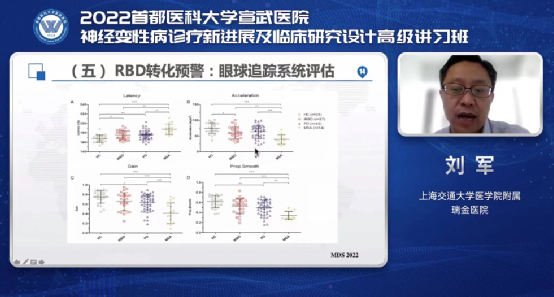
Professor Liu from Ruijin Hospital Affiliated to Shanghai Jiaotong University School of Medicine gave an in-depth interpretation on the early warning of RBD-transformed Parkinson’s disease. He pointed out the importance of early warning of PD to prepare for disease-modifying treatment; the importance of early differential diagnosis of PD for the judgment of prognosis and disease monitoring; more prospective and multi-center studies are needed.
New progress in clinical research on prion diseases -Lectured by Li Sun
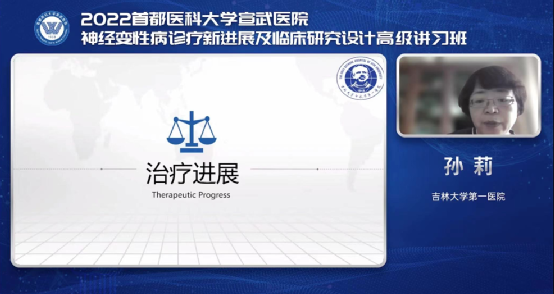
Li Sun, director of the Department of Neurology of the First Hospital of Jilin University, explained the latest progress in clinical research on prion diseases. Prion diseases (PrDs), also known as “transmissible spongiform encephalopathy”, are a class of progressive and fatal neurodegenerative diseases caused by the infection of pathogenic prion proteins. It is characterized by the transformation of intracellular normal prion protein (PrPC) into pathogenic prion protein (PrPSC), which accumulates abnormally in neurons and non-neuronal cells, thereby causing neuronal degeneration and death. There are three main types of manifestations: sporadic, hereditary and acquired.
Whole-process management of Parkinson’s disease diagnosis and treatment -Lectured by Lijuan Wang
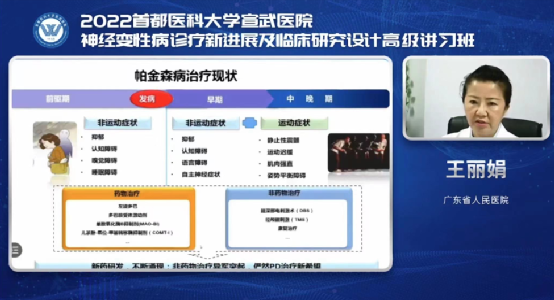
Professor Wang from Guangdong Provincial People’s Hospital gave a detailed explanation of the whole process management of Parkinson’s disease diagnosis and treatment. She mentioned that Parkinson’s disease is currently a major challenge faced by China’s chronic disease prevention and control research, including high incidence and high disability rate, and the global incidence continues to increase, requiring lifelong treatment. At present, there are 2.6 million PD patients in China, accounting for 50% of the total PD in the world. It is estimated that there will be nearly 5 million in 2030, ranking first in the world. PD seriously affects the quality of life and brings a great burden to the family and society. Her team is also making continuous efforts to overcome these problem, including establishing a whole-process management model, screening safe and effective new treatment methods and technologies, optimizing treatment plans, formulating or updating clinical guidelines and pathways for nationwide promotion, and applying for related invention patents.
Research progress of AD peripheral markers -Lectured by Longfei Jia
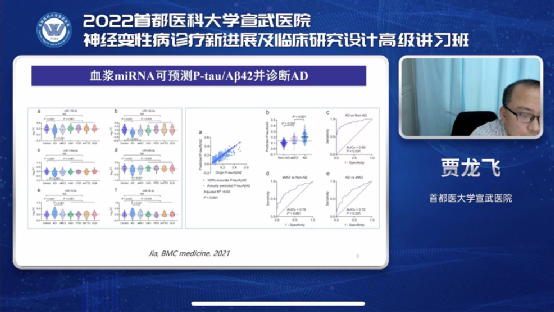
Professor Jia from Xuanwu Hospital of Capital Medical University introduced the latest research progress of AD peripheral markers. The prevalence of dementia among people over 60 years old in China is 6.04%, with 15.07 million people, and the prevalence of mild cognitive impairment is 15.54%, and the number of people has reached 38.77 million. Early diagnosis of AD is imminent, and peripheral markers are a breakthrough point for early diagnosis of AD. He proposed that peripheral blood neuro-derived exosome biomarkers can predict AD 5-7 years in advance, and it is the first time in the world that peripheral blood neuro-derived exosomal synaptic proteins can be used as biomarkers in the asymptomatic period of AD. This is of great significance for the early diagnosis and treatment of AD. Effective diagnosis of AD in the early or asymptomatic stage can buy time for the ultra-early intervention of AD, increase the effectiveness of treatment, and reduce the incidence of the disease.
New progress in electrophysiological research of neurodegenerative diseases-Lectured by Chaoyang Huang
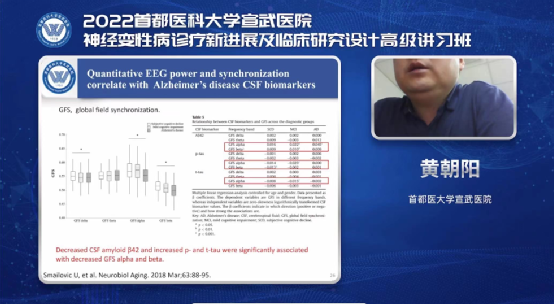
New progress in diagnosis and treatment of dementia with Lewy body-Lectured by Yueyi Yu
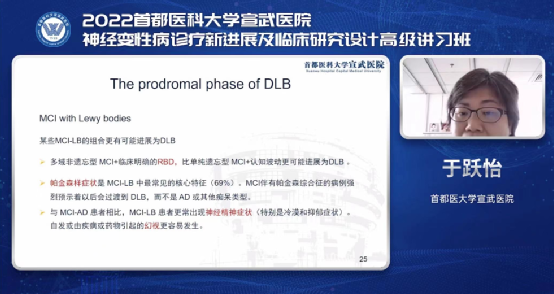
Professor Yu from Xuanwu Hospital gave a detailed interpretation of the new progress in the diagnosis and treatment of dementia with Lewy body. Dementia with Lewy body (DLB) is one of the common neurodegenerative diseases. Some studies believe that the incidence of DLB is second only to AD and ranks second in dementia caused by neurodegenerative diseases. Its main clinical feature is fluctuation. Sexual cognitive dysfunction, visual hallucinations and motor symptoms similar to PD, the main pathological feature is Lewy body (LB), which is widely distributed in the cerebral cortex and brainstem.
Early diagnosis of behavioral variant frontotemporal dementia-Lectured by Fen Wang
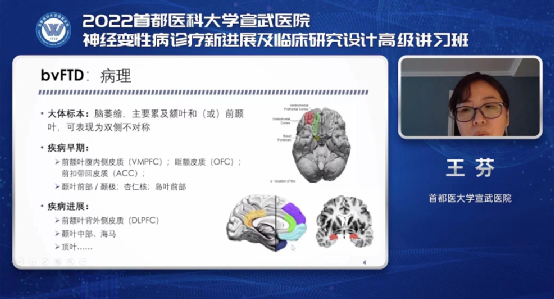
Professor Wang from Xuanwu Hospital introduced the behavioral variant frontotemporal dementia to everyone. Frontotemporal lobar degeneration is a pathological term, while frontotemporal dementia is a clinical syndrome with early-onset dementia as the main manifestation, and the disease is introduced from the pathological, genetic and clinical aspects. Finally, she also explained the four different versions of the diagnostic criteria from 1994 to 2011, as well as the current basis for early diagnosis of the disease.
Nonpharmacological Interventions for Dementia-Lectured by Yi Xing
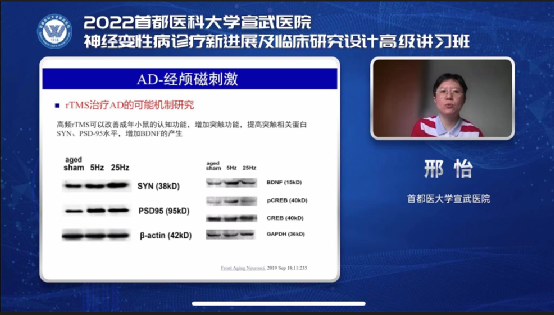
Professor Xing from Xuanwu Hospital of Capital Medical University introduced a randomized controlled study on the efficacy of cognitive training in patients with vascular mild cognitive impairment. The intervention group used computerized multi-cognitive cognitive training: patients trained for half an hour a day, 5 days a week, for 7 consecutive weeks. Training content includes processing speed, attention, sensory perception, long-term memory, working memory, computing, executive control, reasoning and problem solving. The control group was given a training task with a fixed difficulty, and the training content included two aspects of processing speed and attention. For the first time, a rigorous RCT study has confirmed that computerized, multi-cognitive domain, adaptive cognitive training can significantly improve the overall cognitive function and language function of patients with early vascular cognitive impairment.The connection between the DMN and ECN networks was significantly enhanced, which was associated with the improvement of patients’ cognitive function, suggesting that neuroplasticity is an intrinsic mechanism for cognitive training to improve patients’ cognitive function.
This workshop has more than 100,000 online students. During the meeting, the students listened carefully to the lecture, actively asked questions on the message board, and made in-depth discussions with experts on the content of the lecture. After the discussion on the message board, this workshop came to a successful conclusion. The students expressed that the content of this workshop was rich and detailed, and they were very beneficial. At the same time, they also put forward what they wanted to hear in the next workshop and looked forward to the convening of the next workshop.
